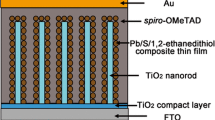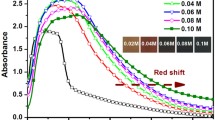Abstract
To increase the loading quantity of PbS quantum-dots, the polysulfide anion (S22−) was firstly introduced in successive ionic layer absorption and reaction process to prepare PbS quantum-dot thin films on TiO2 nanorod arrays. The influence of polysulfide anion (S22−) concentrations in the precursor solution on the deposition of PbS quantum-dot thin films was systematically investigated and the photovoltaic performance of the corresponding solid-state PbS quantum-dot sensitized solar cells with spiro-OMeTAD was evaluated. The loading quantity and crystallinity of PbS quantum-dots increased with the increase of polysulfide anion (S22−) concentrations from 0 to 1 mM and 2 mM. When the polysulfide anion (S22−) concentration was 1 mM and the surface of TiO2 nanorod arrays was modified by 3-mercaptopropionic acid, the optimal photoelectric conversion efficiency of 4.75% was achieved, along with the open-circuit voltage of 0.56 V, short-circuit photocurrent density of 13.00 mA cm−2 and fill factor of 64.8%. The photoelectric conversion efficiency of 4.75% was relatively high in solid-state PbS quantum-dot sensitized solar cells using successive ionic layer absorption and reactions.

To increase the loading quantity of PbS quantum-dots, the polysulfide anion (S22−) was firstly introduced in successive ionic layer absorption and reaction process to prepare PbS quantum-dot thin films on TiO2 nanorod arrays. The optimal photoelectric conversion efficiency of 4.75% was achieved, along with the open-circuit voltage of 0.56 V, short-circuit photocurrent density of 13.00 mA cm−2 and fill factor of 64.8%.




Similar content being viewed by others
References
Abbas MA, Basit MA, Park TJ, Bang JH (2015) Enhanced performance of PbS-sensitized solar cells via controlled successive ionic-layer adsorption and reaction. Phys Chem Chem Phys 17:9752–9760
Bhardwaj S, Pal A, Chatterjee K, Rana TH, Bhattacharya G, Roy SS, Chowdhury P, Sharma GD, Biswas S (2018) Enhanced efficiency of PbS quantum dot-sensitized solar cells using plasmonic photoanode. J Nanopart Res 20:198
Heo JH, Jang MH, Lee MH, You MS, Kim S-W, Lee J-J, Im SH (2017) Formation of uniform PbS quantum dots by a spin-assisted successive precipitation and anion exchange reaction process using PbX2 (X = Br, I) and Na2S precursors. RSC Adv 7(7):3072–3077
Im SH, Kim H-J, Kim S, Kim S-W, Seok SI (2012) Improved air stability of PbS-sensitized solar cell by incorporating ethanedithiol during spin-assisted successive ionic layer adsorption and reaction. Org Electron 13:2352–2357
Jung JY, Zhou K, Um H-D, Guo ZY, Jee S-W, Park K-T, Lee J-H (2011) Effective method to extract optical band gaps in Si nanowire arrays. Opt Lett 36:2677–2679
Jiao J, Zhou Z, Zhou W, Wu S (2013) CdS and PbS quantum dots co-sensitized TiO2 nanorod arrays with improved performance for solar cells application. Mater Sci Semicond Process 16:435–440
Jumabekov AN, Cordes N, Siegler TD, Docampo P, Ivanova A, Fominykh K, Medina DD, Peter LM, Bein T (2016) Passivation of PbS quantum dot surface with L-glutathione in solid-state quantum-dot-sensitized solar cells. ACS Appl Mater Interfaces 8:4600–4607
Karki KJ, Widom JR, Seibt J, Moody I, Lonergan MC, Pullerits T, Marcus AH (2014) Coherent two-dimensional photocurrent spectroscopy in a PbS quantum dot photocell. Nat Commun 5:5869
Licht S (1987) A description of energy conversion in photoelectrochemical solar cells. Nature 300:148–151
Lee Y-L, Chang C-H (2008) Efficient polysulfide electrolyte for CdS quantum dot-sensitized solar cells. J Power Sources 185:584–588
Lee HJ, Wang MK, Chen P et al (2009) Efficient CdSe quantum dot-sensitized solar cells prepared by an improved successive ionic layer adsorption and reaction process. Nano Lett 9:4221–4227
Mcdonald SA, Konstantatos G, Zhang S, Cyr PW, Klem EJD, Levina L, Sargent EH (2005) Solution-processed PbS quantum dot infrared photodetectors and photovoltaics. Nat Mater 4:138–142
Tian J, Shen T, Liu X, Fei C, Lv L, Cao G (2016) Enhanced performance of PbS quantum-dot-sensitized solar cells via optimizing precursor solution and electrolytes. Sci Report 6:23094
Yeon DH, Lee SM, Jo YH, Moon J, Cho YS (2014) Origin of the enhanced photovoltaic characteristics of PbS thin film solar cells processed at near room temperature. J Mater Chem A 2:20112–20117
Zhang ZG, Shi CW, Chen JJ, Xiao GN, Li L (2017a) Combination of short-length TiO2 nanorod arrays and compact PbS quantum-dot thin films for efficient solid-state quantum-dot-sensitized solar cells. Appl Surf Sci 410:8–13
Zhang ZG, Shi CW, Xiao GN, Lv K, Ma CF, Yue JY (2017b) All-solid-state quantum-dot-sensitized solar cells with compact PbS quantum-dot thin films and TiO2 nanorod arrays. Ceram Int 43:10052–10056
Zhang ZG, Shi CW, Lv K, Ma CF, Xiao GN, Ni LL (2018) 200-nm long TiO2 nanorod arrays for efficient solid-state PbS quantum dot-sensitized solar cells. J Energy Chem 27:1214–1218
Funding
This work was financially supported by the National Natural Science Foundation of China (51272061, 51472071) and Talent Project of Hefei University of Technology (75010-037004, 75010-037003).
Author information
Authors and Affiliations
Corresponding author
Ethics declarations
Conflict of interest
The authors declare that there is no conflict of interest.
Electronic supplementary material
ESM 1
(DOC 414 kb)
Rights and permissions
About this article
Cite this article
Lv, K., Shi, C., Ma, C. et al. Introduction of polysulfide anions to increase the loading quantity of PbS quantum-dots for efficient solid-state quantum-dot sensitized TiO2 nanorod array solar cells. J Nanopart Res 21, 2 (2019). https://doi.org/10.1007/s11051-018-4446-5
Received:
Accepted:
Published:
DOI: https://doi.org/10.1007/s11051-018-4446-5




